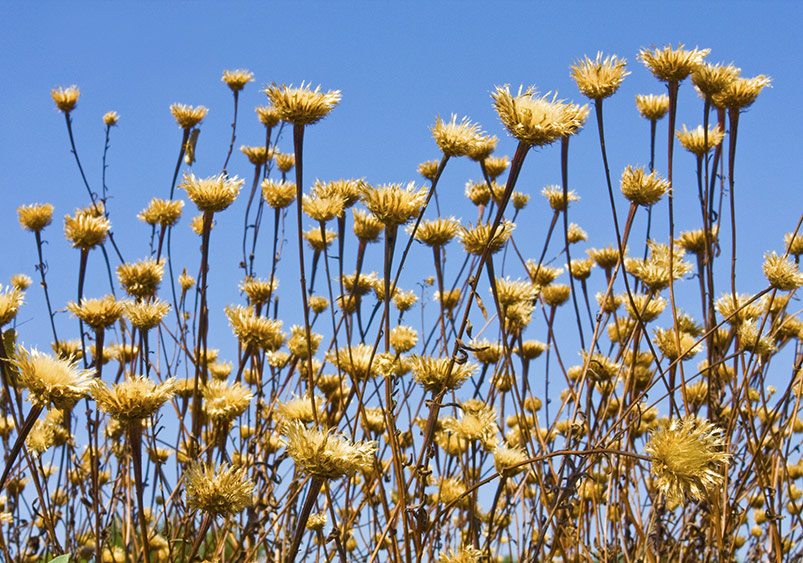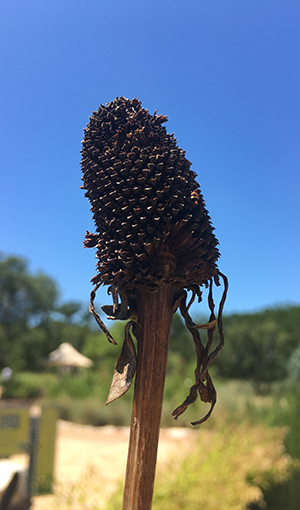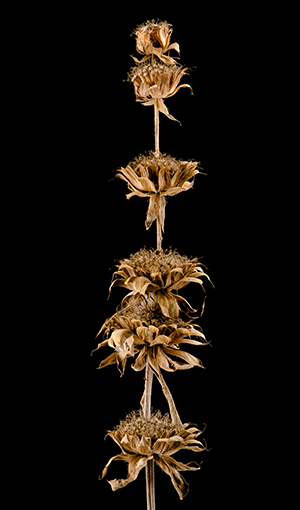Fried and Joy

American basket-flower (Centaurea americana) PHOTO Steven Schwartzman
DEATH IS A TOUGH SUBJECT. And plant death is no exception. When the extended forecast looks like a mirrored hallway displaying never-ending 100s — inciting daily déjà vu across the state of Texas — and the beloved blooms of spring and summer turn brown, crispy and downright fried, plant lovers sometimes find that all that brown makes them feel blue.
The Wildflower Center is here to remind you to not let botanical browns get you down. There is a lot to celebrate in the late-summer garden, from bird food and wildlife habitat to a free refill of next year’s seeds.
Philosopher Alan Watts said that everyone should, at some point, consider death. “The contemplation of death … is very highly generative of creating life,” he claimed. “You’ll get wonderful things out of that.” He was ruminating on the value of humans considering their own mortality, but plant death (and seasonal dormancy) can also be highly generative of life — and very beneficial to the health of gardens and landscapes.
Check out the many ways some of our favorite fried flowers do just that. And, if you’re brave enough, put on a hat and shades and take walk in search of some brown beauties at the Center, in your own neighborhood or along a favorite trail. You might be surprised what catches your eye.

Giant coneflower (Rudbeckia maxima) PHOTO Joanna Wojtkowiak
For the Birds
Our director of communications (also a proud bird nerd), Lee Clippard, got this whole discussion going when he pointed out how awesome it is when giant and purple coneflowers (Rudbeckia maxima and Echinacea purpurea, respectively) turn brown. Why? Because birds such as blue jays, cardinals, pine siskin and goldfinches chow down on seeds filling these plants’ brown center cones (hence the name!). Black-eyed Susans (R. hirta) also provide feathered friends a free lunch. Imagine a food court for birds where the most popular place is “Seed-dog on a Stick,” and you’ve got the right idea.
Director of Horticulture Andrea DeLong-Amaya says, “If I know that wildlife are using a plant, [I] let it stand.” Even when Maximilian sunflowers (Helianthus maximiliani) “get tall and flop over,” a look that’s hard for her to tolerate in a formal garden, she lets them be for one simple reason: “The birds love it!”
DeLong-Amaya points out that some behind-the-scenes plants, native “weeds” that aren’t typically cultivated in a garden setting, can also be “good wildlife forage,” noting prairie tea (Croton monanthogynus), an important food source for doves, quails, songbirds and rodents, and lizard-tail gaura (Oenothera curtiflora) as examples. Bonus: Dead, dying and dormant plants provide insect habitat in addition to satisfying avian munchies.
One-stop Shopping: Mulch, Fertilizer, Seeds
Environmental Designer Michelle Bright says brown plants can be a real lifesaver (literally) on a blazing hot green roof — proving “green” is a broad term that actually incorporates all kinds of living (and not-so-living) colors. Dead and dying wildflowers, as well as dormant herbaceous plants, act as groundcover; like mulch, they help keep water in and insulate soil from heat. Even the basal leaves of aging wildflowers can help. And when those plants and their parts decompose, they fertilize other things growing in their vicinity.
On green roofs and in sun-soaked gardens alike, Bright says we might be tempted to pull annuals such as Texas bluebonnets (Lupinus texensis) or plains coreopsis (Coreopsis tinctoria) that appear past their prime, but if they’re left to go to seed you’ve essentially got an automatically seeded bed for next year. As Cathy Justice, a Center horticulturist, puts it, “Brown flowers don’t bum me out because it means more seeds. The brown flower heads bring anticipation for the beautiful crop of flowers to sprout from those seeds the following year.”
Considering all these benefits, one could save a trip to the garden supply store by simply letting dead and dormant plants do their thing.

Horsemint (Monarda citriodora) PHOTO Wildflower Center
Beauty, Plain and Simple
There are also those of us who simply find dead flowers (as well as dormant perennials and grasses) beautiful. Julie Marcus, a senior horticulturist with the Center, says she likes the look of horsemint (Monarda citriodora) when it turns brown. “It holds its shape and form, which makes it great for dried arrangements.”
Another commonly admired crispy character is American basket-flower (Centaurea americana), which achieves prime basket form late in life when only straw-colored bracts and withered tan petals are left to steal the show.
DeLong-Amaya admits, “Most dead plants in the summer garden bug me!” But there are plenty of exceptions: For instance, she likes the way giant coneflowers look even when they are done flowering. “They retain their strong upright form, which is a nice contrast to other plants in the garden. Purple coneflowers do the same but are less dramatic.” She also mentions inland sea oats (Chasmanthium latifolium) and eryngo (Eryngium leavenworthii) as plants that turn brown over the summer and fall “but continue to look great well into winter.” Woolly ironweed (Vernonia lindheimeri) is another that remains lovely long after the seed is gone.
In Living Color
Our plant experts couldn’t help but point out a few flowers that actually bloom in brown. Besides displaying striking chocolate-colored, orchid-like petals (with small white polka dots, no less!), the seed capsules of swanflower (Aristolochia erecta) offer a further curiosity. According to Plant Conservationist Minnette Marr: “If you return to the same plant for several days after the capsule has opened, you will notice fewer seeds each day even though the capsules do not appear to have been disturbed.” How mysterious! “These empty capsules always remind that there are many unexplored frontiers close at hand,” she adds. Other brown bloomers include coralroot (Corallorhiza wisteriana), purple milkweed vine (Matelea biflora) and various species in the genera Aristolochia and Orobanche. Fresh or fried, brown abounds in the natural world.
It’s important to remember that plants come in all shapes, sizes and colors, and many of those attributes change throughout the year. Joe Marcus, collections manager for the Center and native plant information specialist, points out that the Wildflower Center is “a great lab to see what works through the seasons.” Come out and have a look at what’s not brown and crispy at this point in the summer — such as flame acanthus (Anisacanthus quadrifidus var. wrightii) and cenizo (Leucophyllum frutescens), for instance — and you’ll have a better idea what to plant for color all year. Just remember: Brown is a beautiful color too.

LEFT American basket-flower (Centaurea americana) PHOTO Steven Schwartzman CENTER and RIGHT Inland sea oats (Chasmanthium latifolium) and purple coneflower (Echinacea purpurea), respectively PHOTOS Wildflower Center

